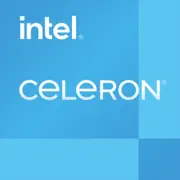Intel Celeron G6900T

Intel Celeron G6900T: Budget Processor for Basic Tasks in 2025
Overview of Features, Assembly Tips, and Comparison with Competitors
Key Features: Architecture and Performance
The Intel Celeron G6900T processor, released in 2022, remains a relevant solution for budget PCs due to its energy efficiency and support for modern technologies.
- Alder Lake Architecture: The first generation of Intel's hybrid design, but Celeron utilizes only Performance-cores (P-cores). There are two cores, without Hyper-Threading support (2 cores / 2 threads).
- Intel 7 Process Technology (10 nm Enhanced SuperFin): Efficient power consumption and reduced heat output.
- Frequency and Cache: Base frequency is 2.80 GHz (no Turbo Boost), L3 cache is 4 MB.
- Integrated Graphics: Intel UHD Graphics 710 with 16 execution units and support for 4K@60 Hz via HDMI/DisplayPort.
- Performance: In the Geekbench 6 test (2025) — 1400 (single-core), 2457 (multi-core). For comparison, the Pentium Gold G7400 scores about ~1600/3000 but is more expensive (~$75).
Key Features:
- Support for PCIe 5.0 (up to 16 lanes) — relevant for future upgrades.
- Compatibility with DDR4 and DDR5 (depends on the motherboard).
- Intel Quick Sync Video technology for video decoding.
Compatible Motherboards: Sockets and Chipsets
The Celeron G6900T uses the LGA 1700 socket, allowing it to be installed on boards with H610, B660, H670, and Z690 chipsets.
- H610: Budget option ($70–90). Examples: ASUS Prime H610M-K, Gigabyte H610M S2H.
- Limitations: No overclocking, 1 PCIe 4.0 slot, 2 DDR4 slots (up to 3200 MHz).
- B660: Optimal choice ($100–130). Example: MSI Pro B660M-A.
- Advantages: Supports DDR4/DDR5 (depending on the model), more USB ports, 2 M.2 slots.
Tip: It's not worth getting motherboards with H670/Z690 chipsets for the Celeron G6900T — that's excessive. Choose H610 or B660 with the required memory type.
Supported Memory: DDR4 vs DDR5
The processor is compatible with DDR4-3200 and DDR5-4800, but the type of memory depends on the motherboard.
- DDR4: In 2025, an 8 GB module costs ~$25. Suitable for office tasks.
- DDR5: Prices have fallen to $40 for 8 GB. Provides a 5–10% performance boost in games and applications, but for Celeron, this is not critical.
Recommendation: For a build based on G6900T, it’s more advantageous to use DDR4 — the performance difference does not justify the extra cost.
Power Supplies: Power Calculation
With a TDP of 35 W, the processor is very power-efficient.
- Without a discrete graphics card: A power supply of 300–400 W is sufficient (for example, be quiet! System Power 10 400W, $45).
- With a graphics card: If you plan to add a GPU like the NVIDIA GTX 1650 (TDP 75 W), choose a PSU of 450–500 W (Corsair CX450, $55).
Important: Even considering upgrades, it’s unnecessary to pay extra for power supplies over 500 W — Celeron won't create a load.
Pros and Cons of Celeron G6900T
Pros:
- Low price ($55–60 in 2025).
- Energy efficiency (ideal for compact builds).
- Support for PCIe 5.0 and 4K video.
Cons:
- Only 2 cores — multitasking is limited.
- No Hyper-Threading — performance drops in applications that utilize multi-threading.
- Weak iGPU for gaming: CS:GO — 40–50 FPS on low settings, GTA V — 25–30 FPS.
Usage Scenarios
1. Office tasks: Document work, browsing (10+ tabs), Zoom conferences — the processor handles it without lag.
2. Home media center: Streaming 4K video, Netflix, YouTube — thanks to Intel Quick Sync.
3. Light gaming: Minecraft, Dota 2, indie titles — on low settings.
4. Educational PCs: Suitable for school/university convertible laptops.
Limitations: Video editing, 3D rendering, streaming — require more powerful CPUs.
Comparison with Competitors
- AMD Athlon 3000G (Zen, 2 cores/4 threads, $50): Lags in single-core performance (Geekbench 6 ~1100) but excels in multitasking.
- Intel Pentium Gold G7400 (2 cores/4 threads, $75): About 20% faster in multi-threading but more expensive.
- Ryzen 3 5300G (4 cores/8 threads, $100): A better choice for gaming, but at a higher price.
Conclusion: Celeron G6900T is the most affordable option but only for basic needs.
Practical Assembly Tips
1. Motherboard: Gigabyte H610M S2H DDR4 ($75) + 8 GB DDR4-3200 ($25).
2. Storage: 256 GB NVMe SSD (Kingston NV2, $30).
3. Cooling: The stock cooler is sufficient — minimal noise.
4. Case: Compact Mini-ITX (Cooler Master Elite 110, $50).
Example build:
- Processor: $60
- Motherboard: $75
- Memory: $25
- SSD: $30
- PSU: $45
- Case: $50
Total: ~$285 (excluding OS and monitor).
Final Conclusion: Who is Celeron G6900T Suitable For?
This processor is an ideal choice for those who:
- Are building a PC for office, study, or browsing.
- Want a mini-PC for media center (HTPC).
- Are looking for a budget replacement for an outdated CPU without upgrading other components.
Why is it still relevant in 2025? Low price, compatibility with new chipsets and DDR5, minimal power consumption. However, for gaming or intensive tasks, it’s better to add $20–30 and get a Pentium Gold or Ryzen 3.
If you want a maximally budget-friendly but modern system, the Celeron G6900T remains a worthy option. But keep in mind: its capabilities are limited, and an upgrade in 2–3 years is inevitable.
Basic
CPU Specifications
Memory Specifications
GPU Specifications
Miscellaneous
Benchmarks
Compared to Other CPU
Share in social media
Or Link To Us
<a href="https://cputronic.com/en/cpu/intel-celeron-g6900t" target="_blank">Intel Celeron G6900T</a>